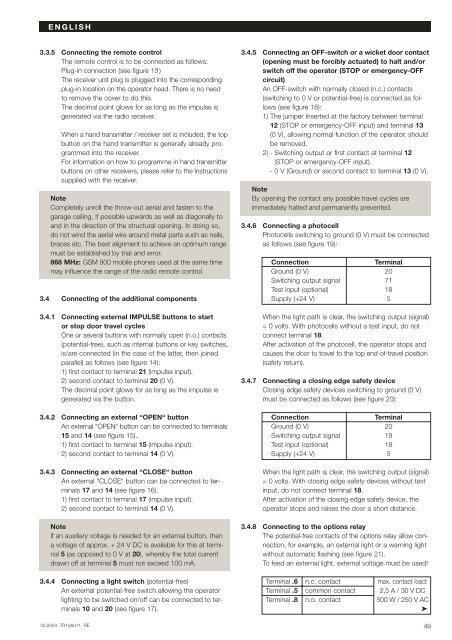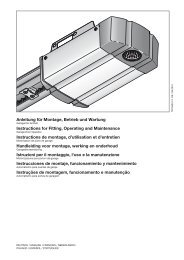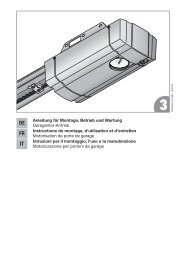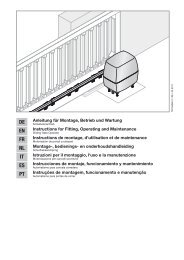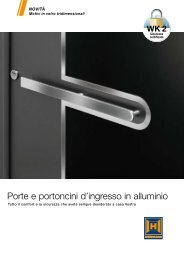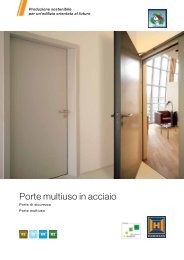SupraMatic E P 9 Notice - Hormann.fr
SupraMatic E P 9 Notice - Hormann.fr
SupraMatic E P 9 Notice - Hormann.fr
- No tags were found...
Create successful ePaper yourself
Turn your PDF publications into a flip-book with our unique Google optimized e-Paper software.
ENGLISH3.3.5 Connecting the remote controlThe remote control is to be connected as follows:Plug-in connection (see figure 13)The receiver unit plug is plugged into the correspondingplug-in location on the operator head. There is no needto remove the cover to do this.The decimal point glows for as long as the impulse isgenerated via the radio receiver.When a hand transmitter / receiver set is included, the topbutton on the hand transmitter is generally already programmedinto the receiver.For information on how to programme in hand transmitterbuttons on other receivers, please refer to the instructionssupplied with the receiver.NoteCompletely unroll the throw-out aerial and fasten to thegarage ceiling, if possible upwards as well as diagonally toand in the direction of the structural opening. In doing so,do not wind the aerial wire around metal parts such as nails,braces etc. The best alignment to achieve an optimum rangemust be established by trial and error.868 MHz: GSM 900 mobile phones used at the same timemay influence the range of the radio remote control.3.4 Connecting of the additional components3.4.1 Connecting external IMPULSE buttons to startor stop door travel cyclesOne or several buttons with normally open (n.o.) contacts(potential-<strong>fr</strong>ee), such as internal buttons or key switches,is/are connected (in the case of the latter, then joinedparallel) as follows (see figure 14):1) first contact to terminal 21 (impulse input).2) second contact to terminal 20 (0 V).The decimal point glows for as long as the impulse isgenerated via the button.3.4.2 Connecting an external “OPEN“ buttonAn external “OPEN“ button can be connected to terminals15 and 14 (see figure 15).1) first contact to terminal 15 (impulse input).2) second contact to terminal 14 (0 V).3.4.3 Connecting an external “CLOSE“ buttonAn external “CLOSE“ button can be connected to terminals17 and 14 (see figure 16).1) first contact to terminal 17 (impulse input).2) second contact to terminal 14 (0 V).NoteIf an auxiliary voltage is needed for an external button, thena voltage of approx. + 24 V DC is available for this at terminal5 (as opposed to 0 V at 20), whereby the total currentdrawn off at terminal 5 must not exceed 100 mA.3.4.4 Connecting a light switch (potential-<strong>fr</strong>ee)An external potential-<strong>fr</strong>ee switch allowing the operatorlighting to be switched on/off can be connected to terminals10 and 20 (see figure 17).05.2004 TR10A011 RE3.4.5 Connecting an OFF-switch or a wicket door contact(opening must be forcibly actuated) to halt and/orswitch off the operator (STOP or emergency-OFFcircuit)An OFF-switch with normally closed (n.c.) contacts(switching to 0 V or potential-<strong>fr</strong>ee) is connected as follows(see figure 18):1) The jumper inserted at the factory between terminal12 (STOP or emergency-OFF input) and terminal 13(0 V), allowing normal function of the operator, shouldbe removed.2) - Switching output or first contact at terminal 12(STOP or emergency-OFF input).- 0 V (Ground) or second contact to terminal 13 (0 V).NoteBy opening the contact any possible travel cycles areimmediately halted and permanently prevented.3.4.6 Connecting a photocellPhotocells switching to ground (0 V) must be connectedas follows (see figure 19):ConnectionTerminalGround (0 V) 20Switching output signal 71Test input (optional) 18Supply (+24 V) 5When the light path is clear, the switching output (signal)= 0 volts. With photocells without a test input, do notconnect terminal 18.After activation of the photocell, the operator stops andcauses the door to travel to the top end-of-travel position(safety return).3.4.7 Connecting a closing edge safety deviceClosing edge safety devices switching to ground (0 V)must be connected as follows (see figure 20):ConnectionTerminalGround (0 V) 20Switching output signal 19Test input (optional) 18Supply (+24 V) 5When the light path is clear, the switching output (signal)= 0 volts. With closing edge safety devices without testinput, do not connect terminal 18.After activation of the closing edge safety device, theoperator stops and raises the door a short distance.3.4.8 Connecting to the options relayThe potential-<strong>fr</strong>ee contacts of the options relay allow connection,for example, an external light or a warning lightwithout automatic flashing (see figure 21).To feed an external light, external voltage must be used!Terminal .6 n.c. contact max. contact load:Terminal .5 common contact 2,5 A / 30 V DCTerminal .8 n.o. contact 500 W / 250 V AC➤49


